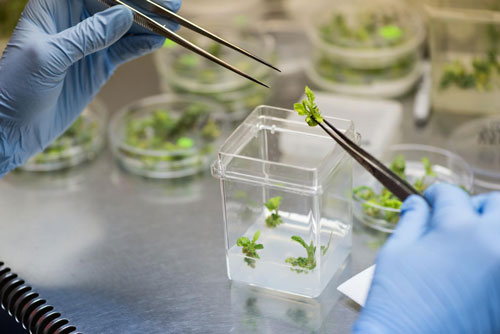| Aug 30, 2016 |
More tomatoes, faster: Accelerating tomato engineering
|
|
(Nanowerk News) Tomatoes are already an ideal model species for plant research, but scientists at the Boyce Thompson Institute (BTI) just made them even more useful by cutting the time required to modify their genes by six weeks.
|
|
While looking for ways to make tomatoes and other crop plants more productive, BTI Assistant Professor Joyce Van Eck and former postdoctoral scientist Sarika Gupta developed a better method for "transforming" a tomato--a process that involves inserting DNA into the tomato genome and growing a new plant. By adding the plant hormone auxin to the medium that supports growth of tomato cells, they can speed up the plant's growth, ultimately accelerating the pace of their research.
|
|
They describe this advance in a study published in Plant Cell, Tissue and Organ Culture ("Modification of plant regeneration medium decreases the time for recovery of Solanum lycopersicum cultivar M82 stable transgenic lines").
|
 |
| A researcher transfers a tomato plantlet into root induction medium to encourage the growth of roots.
|
|
Typically, transformation works by using a soil bacterium called Agrobacterium tumefaciens to insert a new segment of DNA into the cells of tomato seedling tissues. The transformed cells are transplanted onto plant regeneration medium, which contains nutrients and hormones that cause the tissue to grow into a tiny new plant. These plantlets are then transferred to root induction medium where they grow roots, before being planted in soil and hardened in the greenhouse. In the new method, the Van Eck lab adds auxin to the regeneration and rooting media. The addition reduces the length of the procedure from 17 weeks to just 11.
|
|
"If you can speed up the plant development, which is what the auxin is doing, you can decrease the time it takes to get genetically engineered lines," said Van Eck.
|
|
Researchers in the Van Eck lab perform tomato transformations routinely, as a research method to understand how individual genes affect tomato growth and development. Their new protocol not only saves time, but uses fewer materials, and saves money. The researchers can then finish experiments sooner and potentially run more projects at once.
|
|
The project came out of a collaboration with Cold Spring Harbor Laboratory to identify gene pathways that could be used to breed crops with higher yields.
|
|
"We're looking at the genes and gene networks involved in stem cell proliferation, meristem development and flowering and branching," said Van Eck, "with the end goal being that maybe genes that we identify in tomato, which is strictly being used as a model, might help us understand what can be done to increase yield in other crops."
|

